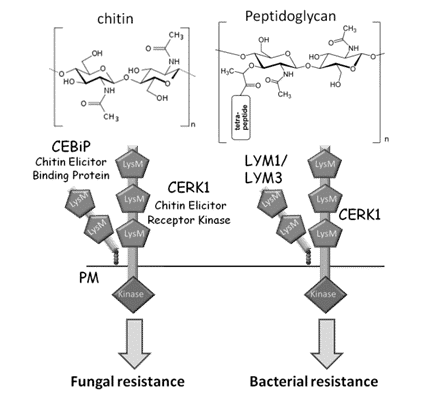The innate immunity constitutes the first line of defence against attempted microbial invasion and is a well-described phenomenon in vertebrates and insects. Like animals, plants have acquired the ability to recognize, as non-self, invariant pathogen-associated molecular patterns (PAMP), characteristic of microbial organisms but completely absent in potential host plants[i].
Microbial glycans, such as bacterial peptidoglycan (PGN) or fungal chitin are important signatures for plant immune activation. On the other hand, plant receptor proteins carrying extracellular lysyn motifs (LysM) serve as biochemical modules implicated in the recognition of these different N-acetylglucosamine (GlcNAc)-containing ligands, facilitating the establishment of plant resistance to bacterial and fungal pathogens[ii].

Therefore, the detailed analysis of PGN and chitooligosaccharides recognition and binding by LysM domains is critically important to understand the molecular mechanisms leading to the activation of downstream defense responses triggered by these PAMPs. Within this frame, a multidisciplinary approach combining NMR spectroscopy with protein mutagenesis and docking analysis has been carried out to explore the molecular recognition processes between the aforementioned microbial glycans and their host plant receptors.
[i]A. A. Gust, R. Willmann, Y. Desaki, H. M. Grabherr, T. Nürnberger. Trends Plant Sci. 2012; 17(8): 495–502.
[ii] R. Willmann et al. Proc Natl Acad Sci U S A. 2011; 108(49): 19824–19829.

